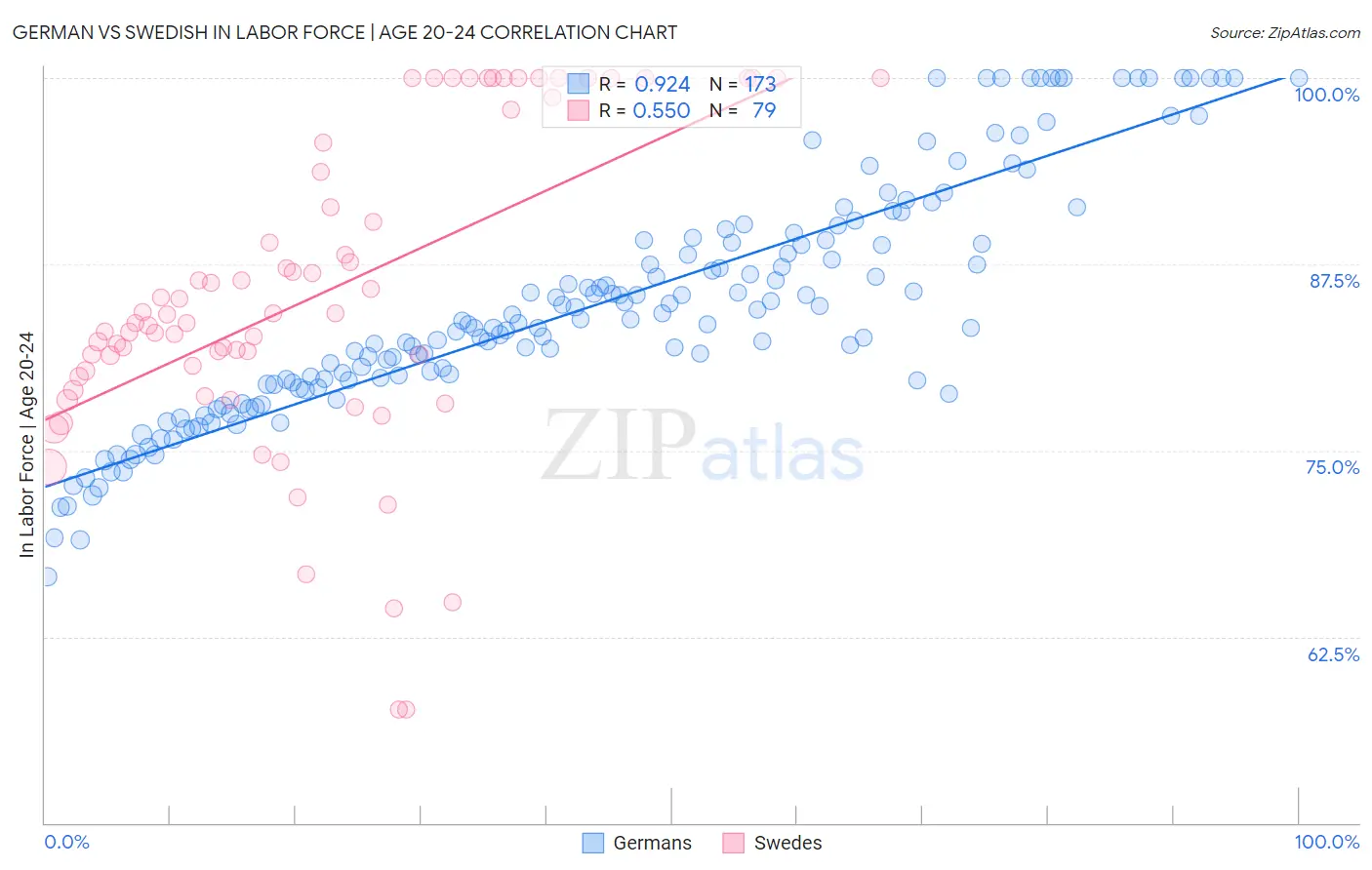German vs Swedish In Labor Force | Age 20-24
COMPARE
German
Swedish
In Labor Force | Age 20-24
In Labor Force | Age 20-24 Comparison
Germans
Swedes
78.6%
IN LABOR FORCE | AGE 20-24
100.0/ 100
METRIC RATING
12th/ 347
METRIC RANK
78.8%
IN LABOR FORCE | AGE 20-24
100.0/ 100
METRIC RATING
9th/ 347
METRIC RANK
German vs Swedish In Labor Force | Age 20-24 Correlation Chart
The statistical analysis conducted on geographies consisting of 578,744,060 people shows a near-perfect positive correlation between the proportion of Germans and labor force participation rate among population between the ages 20 and 24 in the United States with a correlation coefficient (R) of 0.924 and weighted average of 78.6%. Similarly, the statistical analysis conducted on geographies consisting of 538,164,941 people shows a substantial positive correlation between the proportion of Swedes and labor force participation rate among population between the ages 20 and 24 in the United States with a correlation coefficient (R) of 0.550 and weighted average of 78.8%, a difference of 0.30%.

In Labor Force | Age 20-24 Correlation Summary
| Measurement | German | Swedish |
| Minimum | 66.5% | 57.6% |
| Maximum | 100.0% | 100.0% |
| Range | 33.5% | 42.4% |
| Mean | 84.7% | 85.4% |
| Median | 83.6% | 83.6% |
| Interquartile 25% (IQ1) | 79.5% | 80.0% |
| Interquartile 75% (IQ3) | 89.1% | 95.6% |
| Interquartile Range (IQR) | 9.6% | 15.7% |
| Standard Deviation (Sample) | 7.8% | 10.4% |
| Standard Deviation (Population) | 7.8% | 10.4% |
Demographics Similar to Germans and Swedes by In Labor Force | Age 20-24
In terms of in labor force | age 20-24, the demographic groups most similar to Germans are Scandinavian (78.5%, a difference of 0.070%), Czech (78.5%, a difference of 0.070%), Finnish (78.7%, a difference of 0.11%), Slovene (78.7%, a difference of 0.15%), and Sudanese (78.4%, a difference of 0.21%). Similarly, the demographic groups most similar to Swedes are Immigrants from Cabo Verde (78.9%, a difference of 0.070%), Slovene (78.7%, a difference of 0.16%), Luxembourger (79.0%, a difference of 0.17%), Finnish (78.7%, a difference of 0.19%), and Danish (79.0%, a difference of 0.21%).
| Demographics | Rating | Rank | In Labor Force | Age 20-24 |
| Norwegians | 100.0 /100 | #1 | Exceptional 80.1% |
| Immigrants | Somalia | 100.0 /100 | #2 | Exceptional 79.5% |
| Somalis | 100.0 /100 | #3 | Exceptional 79.3% |
| Alaskan Athabascans | 100.0 /100 | #4 | Exceptional 79.1% |
| Aleuts | 100.0 /100 | #5 | Exceptional 79.0% |
| Danes | 100.0 /100 | #6 | Exceptional 79.0% |
| Luxembourgers | 100.0 /100 | #7 | Exceptional 79.0% |
| Immigrants | Cabo Verde | 100.0 /100 | #8 | Exceptional 78.9% |
| Swedes | 100.0 /100 | #9 | Exceptional 78.8% |
| Slovenes | 100.0 /100 | #10 | Exceptional 78.7% |
| Finns | 100.0 /100 | #11 | Exceptional 78.7% |
| Germans | 100.0 /100 | #12 | Exceptional 78.6% |
| Scandinavians | 100.0 /100 | #13 | Exceptional 78.5% |
| Czechs | 100.0 /100 | #14 | Exceptional 78.5% |
| Sudanese | 100.0 /100 | #15 | Exceptional 78.4% |
| Dutch | 100.0 /100 | #16 | Exceptional 78.4% |
| Cape Verdeans | 100.0 /100 | #17 | Exceptional 78.3% |
| Immigrants | Bosnia and Herzegovina | 100.0 /100 | #18 | Exceptional 78.1% |
| Bangladeshis | 100.0 /100 | #19 | Exceptional 78.1% |
| French Canadians | 100.0 /100 | #20 | Exceptional 78.1% |